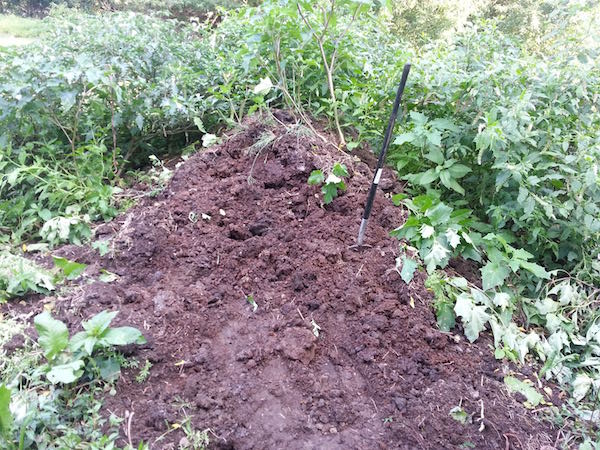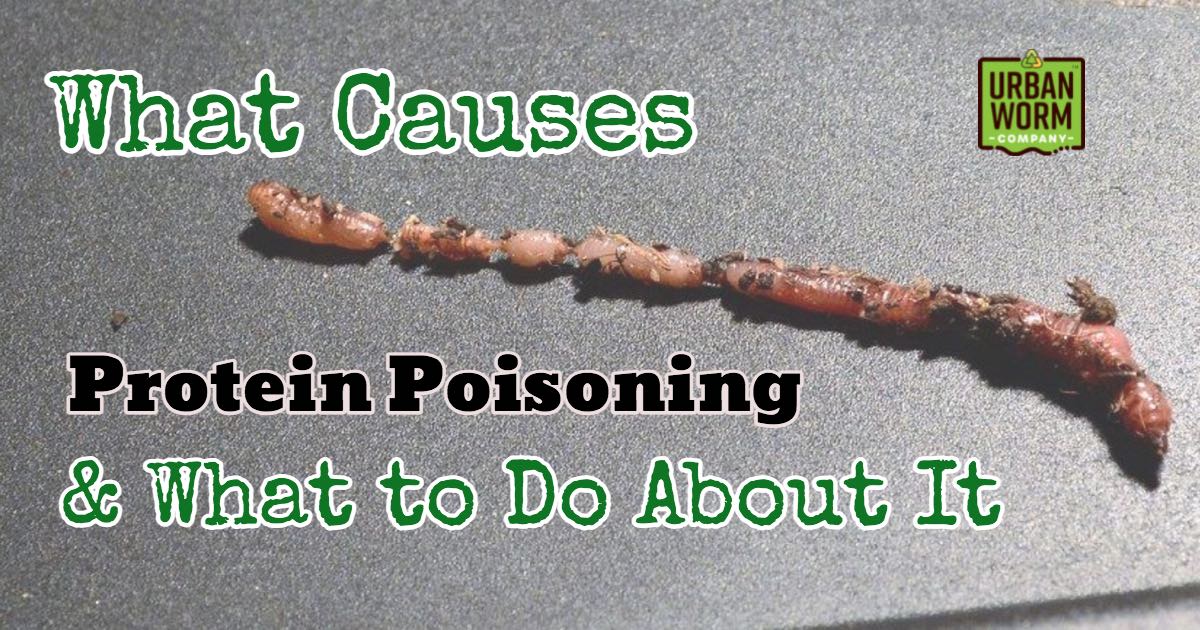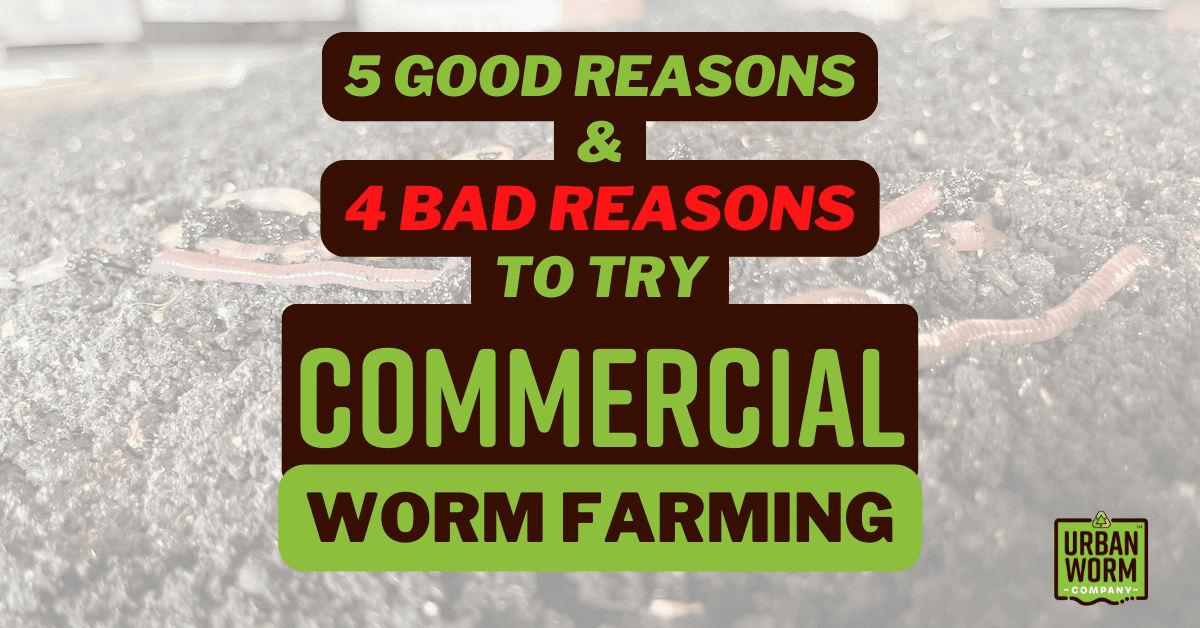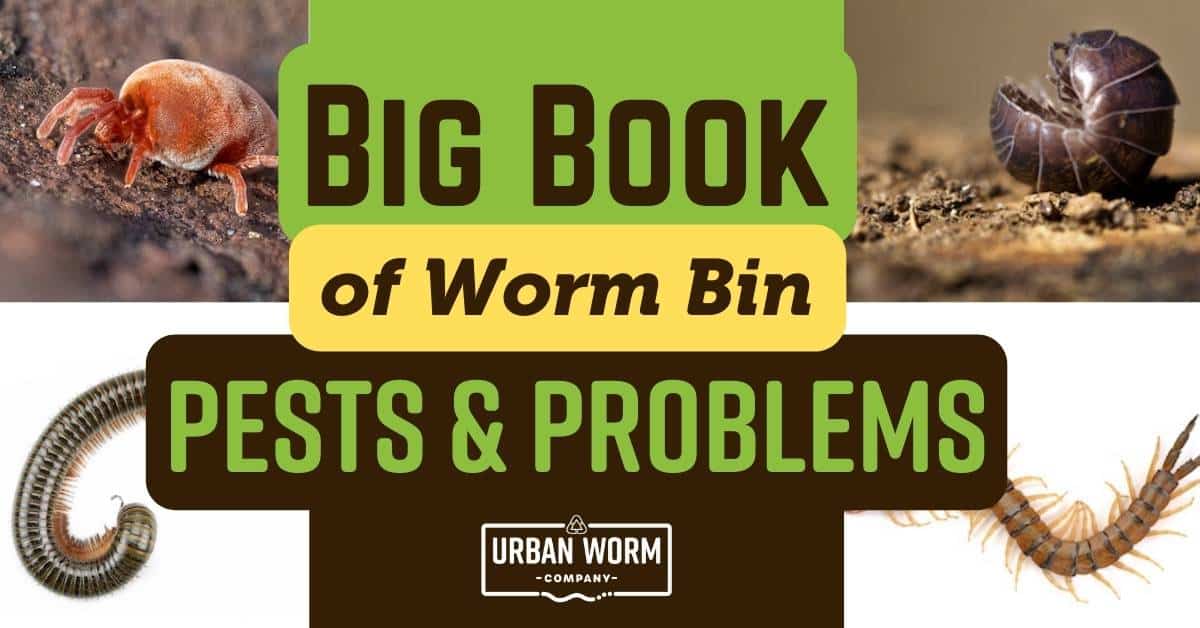
Hands down, I think aged horse manure is the best natural bedding and habitat for composting worms. Red Wigglers have many names, manure worms being one of them….maybe an indication horse manure might be pretty awesome, no? Not convinced? Read on.
2022 Update: Be wary of the possibility of persistent herbicides in horse manure. Hay farmers often use highly effective anti-thistle herbicides that will not break down in either the hot composting or vermicomposting processes.
These are deadly to certain vegetable crops.
Dual Purpose
One of the best reasons you should use horse manure as a medium is that it acts as bedding and a ready source of food. Unlike a straight peat moss habitat, you can head out for vacation knowing you’ve just provided your guys or girls (or “guygirls” since worms are hermaphroditic, right?) a sweet place to hang out AND eat. Kind of the worm equivalent of wheeling your BarcaLounger, widescreen LCD, and NFL Sunday Ticket into the Old Country Buffet. Now if vermicomposting your kitchen waste is your objective, you’ll be using it more as a bedding than munchies, but that shouldn’t keep you from listing horse manure as the #1 bedding for your system.
It Doesn’t Smell
Period. If it does, it’s not aged enough, is still off-gassing ammonia, or it’s mixed with something else stinky.
Extremely Low Cost (like nada.)
Another reason is that it’s free, assuming you don’t go to great expense to collect it. Though I’m only a few minutes from Philadelphia, I have a small farm and children’s petting zoo within a 5-minute walk from my house. Lucky, right? (Even luckier that the owner doesn’t care when I stop by for a load.)
Free Worms!
And I suppose you wouldn’t mind free worms with your free manure, right? Seriously, my last load of horse manure probably had $60-80 retail value in Red Wigglers, more than paying for the cost of renting the truck from Home Depot. And those worms in there have been getting it on with other worms, making little babies along the way, something you probably won’t even notice from the end of your shovel. In fact, I’m reserving one of my beds for an experiment to see if a bed of horse manure will populate itself into a dense population within a year.
Huge Time Saver
If you take your worm fetish (that’s what my wife calls it) beyond the confines of an Urban Worm Bag or Rubbermaid bin, dumping a load of horse manure in your container, bed or windrow will save you mucho time and hassle in shredding cardboard, egg cartons, newsprint.
But before you run out for your horse doody, follow a couple basic guidelines.
- Make sure the horse manure is aged for at least 3 months. This is for two reasons. First, the manure itself must first go through its thermophyllic, or hot stage of composting. Red Wigglers get really grumpy above 90F, slowing down eating and hooking up with each other (note to self: create Tinder App for worms) and your composting horse manure can reach 150°F.
- Secondly, the horses are probably given deworming medicine several times per year. While you can still use this manure, the deworming agent present in the medicine MUST be given time to break down. Pro tip: If you find worms present in the horse manure, you’re good. (Update: there is some good evidence the deworming breaks down fairly quickly and is not as harmful to worms as previously thought.)
- Ask the owner for permission! Shotguns and electric fences are no fun! 🙂
Now the next step is finding your source. And you won’t need much. In fact, if you’ve ever seen a parade, you’ve seen a horse drop a pretty impressive load right in front of you. Just a single horse’s, um, “output” will give you more than you need. It’s just a matter of having the courage to ask to take it.
Got any input on your favorite bedding? Think horsepucky is horsepucky? I’d love to hear it in the comments below.




I use aged horse manure too, but I also add cut up card board. I have around 1400 European Night crawlers in an old deep freezer and they are having babies like crazy. I guess that I should have around 5000 or 6000 worms by Spring. I also keep a little light from an old microwave oven inside taped to the door. It keeps a little light inside and it also keep the temperature around 70 + degrees inside the worm bin. I turn the bed at least once a week and add a little water about twice a week. Maybe by Spring I will have enough to start another worm bin in another freezer. Anyway, the worms are doing great!
Awesome example of repurposing old equipment Keith. I’m a huge proponent of the aged manure, but adding tried and true bedding like cardboard gives you a real nice buffer when the worms work through all the manure, which mine seem to do fairly quickly.
Im using half composted leaves. The worms love them. Never any chemicals that way. By hot composting , the bedding is disease free. By mulching leaves while I mow the grass, I get perfect compost, just add water and a little time.
I simply made a wooden bin, added soil and vegies scraps and a handfull of worms. Whenever i get scraps i dump them in along with a nice little watering when needed.There are literally thousands of mini worms in there now after just 3 months! I’ve begun to spread them into other wooden bins I’m growing vegies in. But I do wish to try the paper and manure methods too. Thanks for the info.
I have a pile of aged horse manure about 8 feet high (4 horses X 6 months) which I’ve mixed with some hardwood mulch for composting. Will this get too hot for night crawlers?
Hi Steven,
If it’s truly aged, then it won’t get hot and the presence of wood chips won’t make it hot either.
You mentioned nightcrawlers, but I think you probably mean a Canadian Nightcrawler or possibly African Nightcrawler rather than a European Nightcrawler. Of those two, the African is the only composting worm, but I am not sure how it would process an 8-ft high pile.
Considering your mixture of horse manure and wood chips, this sounds like a wonderful situation for a windrow or shallow composting beds for red wigglers.
What? My European Nightcrawlers love horse manure! That’s all I use and they tear through it and multiply like crazy. Not sure where you got the info that African nightcrawlers are the only composting nightcrawlers.
Hi Mark,
This is more of a naming issue, IMO. European Nightcrawlers aren’t closely related to the kind of nightcrawlers you’d dig from the ground. They’re epigeic cousins of the Red Wiggler, so they live just above the topsoil layer but just below loose organic matter like leaf litter and manure.
Hi, Steve!
I’m new to vermicomposting. Can I use the bagged manure I can get from the garden center for bedding? I have a wood flow thru tray system.
Thanks!
Hey Betty! Firstly, thanks for registering on the Urban Worm Network!
Secondly, yes, you should be fine with bagged manure. It’s not going to be the best thing out there, but on the spectrum of starter material, it’s below living vermicompost, but better than saturated paper. And speaking of saturation, manure’s capacity for water retention is pretty impressive and I have to imagine anything bagged a a garden center is going to be fairly dry, so make sure you give it a good, thorough soaking.
Cheers!
Steve
What about if the horse has eaten hay that has been sprayed for bugs , will the manure still be ok to use after it has aged for 3 months??
Hi Dan,
In general, you should be OK. There’s a bunch of time between when the original crop (that the hay was made from) was sprayed and when you would be using the end product of the horse manure. Time, sunlight, and the trip through the horse’s gut should do the trick. The only caveat is if the horse was eating hay that was originally sprayed with persistent pesticides.
Steve
Just came across your site. Think I can learn a lot from you guys. I am from Penang, Malaysia and I have started breeding African Night Crawlers.
It’s great to have you, Lek!
When I was 12 or so, we had horses. I piled the hay bedding with manure from the stalls outside the barn. One day I raked the top of it and the wigglers were unbelievable, I never bought or dug in the woods for worms to fish with again…these guys were gymnasts
!
Hallo Steve, Bula from the Fiji
Is cow manure and goat manure good for worm bedding and/or feed as well?
I dont have access to horse manure but live close to people with cows and goats so was wondering if those are good alternatives.
Many thanks!
Siteri R
Hi Siteri!
They can be, but just like aged horse manure, the cow and goat manure must go through a precomposting phase where it has gone through a couple heating cycles to raise the C:N ration to a point where it will not begin hot composting the worms.
I just found this site and love all the info! Thank you so much! I have a question, what do you mix with the manure? Do you just use 100% manure to put in my worm tub or do I mix with peat moss or dirt or something else? Thank you!
Thanks Susan! 🙂 If your manure is aged, you can use it as is. If it still smells of ammonia, then I would eefinitely mix in with some coco coir. Peat moss is OK too, but I prefer the coir!
can i use saw dust and horse poo ?
Absolutely!
I have dairy goats and an abundance of goat poop. Would worms like goat poop? Also I saw that sawdust is ok. Is there any tree that you shouldn’t use the saw dust from?
Hi Sierra,
Goat manure is great! And other than *maybe* black walnut due to the juglone, I think sawdust from most trees would be fine!
Cheers,
Steve
They also love rabbit manure.
I am new to this, I ordered horse manure and I orderd worms, The manure got delayed, so my worms came first. How can make sure to keep worms alive
With two horses, trying to turn my manure compost became a nightmare. My solution was to let worms do it. Yes, it gets hot. And I get PLENTY of worms. They just avoid the hot spots. My bins are 5 1/2’x11’x3′. I don’t use bedding and the only thing in my manure bins is manure. The worms love it; Because I live in an arid climate I do sprinkle it for a couple minutes daily. By the time the second bin is full, the first is ready to remove. I live on a sand dune, so the vermiposted manure is a godsend.
I have a horse manure/urine pile started in 2016. Mixed in is their sawdust shavings bedding. In August 2020 I finally got to turning it. Some was more composted than most. Turning mixed the sawdust more evenly. The pile was hot when I turned it, you could feel heat in tractor. I didn’t see any worms. My pastures are fairly new and getting them established has been a lot of trial and error. The soil looks malnourished, I believe the top soil had been stripped and taken off site. I’d love to get a billion worms going before I spread the mix over the pasture to help rehab the soil. My plan was to spread a pile this fall when seeding. If I knew I could get a billion worms going by next fall in this pile I’d hold off a year. Advice?
Oh, forgot to ask, could I seed the pile with a bag or two of commercially sold worms?
How about composted cow manure? I have a good supply of it.
If it’s already composted…..yep! 🙂
How about Spanish Moss?
Hi Steve, I found a source of free horse manure! How much would I need to start my urban worm bag? Thank you!
Does cardboard have any toxins in it? I would be surprised if it didn’t.
I can’t say definitively in all case, but I generally consider all cardboards to be fine for my worms.
From other websites I have learned it’s worth it to get a soil tester to check temp, moisture, and ph level. Neutral is recommended as best at 6.7, but my bed regularly at 7.3 and yet my worms are fine. Also, once you choose red worms or crawlers of any type, don’t waste $$ and mix the varieties cause they won’t crossbreed. And if you use newspaper shred, only use black/white print. What I have enjoyed is that I use my bed mostly to pot succulents. My wife often gives me waste tomatoes and the culled leaves from strawberries, and often get volunteers growing thru my cactus. Now that’s a freebie to thank God for!! And for the rookies, I started with a 40 gal Tupperware container wi/lid, in a shaded area. I filled it 2/3 full with 6-7 5 gal buckets of soil, 1 gal of food scraps, 1/2 gal of cow manure, 1 gal of horse manure, a bit of sawdust, and hedge clippings run thru a wood chipper. My red worms thrive!! of course I add food scraps, 1 gal coffee grounds every 10 days, and turn the soil twice a week.
Some trivia I saw online: there is an African earthworm 3′ long! There is species from Australia 10′ long!!!
Thanks for your post Ed. Good info! I like your formula/recipe for your bin (I’ll substitute composted horse manure). My question is…once you have the container filled, when do you actually harvest the black gold and start the process over? Thanks! Cheryl
Hey Cheryl. Generally after two to three months you should have some finished worm compost that you can harvest. If you harvest and there are lots of big chunks, you can just toss them back on the top of the bin to be processed again.
Can horse manure be used without being pre-composted? if it is added in thin layers to the CFT system? My horse manure will be coming from my horses and I know what goes into them.
It’s best if you let the manure age a bit. I wait until it starts to be a bit crumbly in texture. Maybe two to three months old at least.